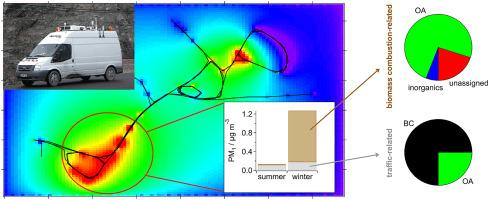Atmospheric Environment ( IF 4.2 ) Pub Date : 2021-07-30 , DOI: 10.1016/j.atmosenv.2021.118648 Friederike Fachinger 1 , Frank Drewnick 1 , Stephan Borrmann 1, 2

|
Mobile mapping experiments were performed in two villages (~400 and ~2500 inhabitants, respectively) in France and Germany in both summer and winter in order to assess the pollutant distribution of several particulate matter (PM) related pollutants (particle number concentration, PM1, PM2.5, PM10; PM1 chemical composition, including inorganic and organic species, black carbon, and polyaromatic hydrocarbons) as well as CO2. Two dominating local emission contributions were found: traffic contributed to organic aerosol (OA), CO2, particle number concentration, PM1, black carbon, and polyaromatic hydrocarbons, whereas significant primary emission contributions from biomass combustion were found for OA, PM1, sulfate, nitrate, and chloride. In order to quantify the respective contributions from these two sources, emission ratios of pollutants to OA were determined. By these means, contributions of traffic and biomass combustion to total PM1 could be disentangled, and it was found that even though traffic-related PM1 was higher in winter than in summer, the majority of additional locally emitted PM1 in winter was due to emissions from biomass combustion. Non-refractory inorganic components were found to make up ~5% of total PM1 primary emissions from biomass combustion. While strongly enhanced pollutant concentrations were observed under inversion conditions, the relative contributions of local emissions to the locally measured pollutant burden seemed not to be altered under such conditions.
中文翻译:

村庄如何为当地空气质量做出贡献——通过 PM 及其成分的移动映射评估的交通和生物质燃烧相关排放的影响
夏季和冬季在法国和德国的两个村庄(分别为约 400 和约 2500 名居民)进行了移动测绘实验,以评估几种与颗粒物 (PM) 相关的污染物(颗粒数浓度,PM 1、PM 2.5、PM 10;PM 1化学成分,包括无机和有机物质、黑碳和多环芳烃)以及 CO 2。发现了两个主要的局部排放贡献:交通对有机气溶胶 (OA)、CO 2、粒子数浓度、PM 1 的贡献、黑碳和多环芳烃,而生物质燃烧对 OA、PM 1、硫酸盐、硝酸盐和氯化物的主要排放贡献很大。为了量化这两种来源的各自贡献,确定了污染物与 OA 的排放比率。通过这些方式,交通和生物量燃烧对 PM 1总量的贡献可以被解开,并且发现即使与交通相关的 PM 1在冬季高于夏季,冬季额外的大部分本地排放的 PM 1是由于生物质燃烧产生的排放。发现非耐火无机成分占 PM 1总量的约 5%生物质燃烧的主要排放物。虽然在反演条件下观察到污染物浓度大大增加,但在这种条件下,当地排放对当地测量的污染物负荷的相对贡献似乎没有改变。











































 京公网安备 11010802027423号
京公网安备 11010802027423号